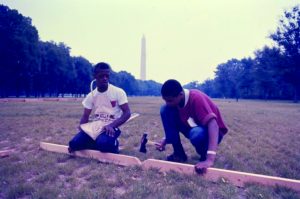A new exhibition at the National Underground Railroad Freedom Center is illuminating the often-overlooked history of the multicultural movement to confront poverty that redefined social justice and activism in America. Solidarity Now! 1968 Poor People’s Campaign, organized by the Smithsonian Institution Traveling Exhibition Service (SITES) and the National Museum of African American History and Culture, opens March 30 at the Freedom Center.
In the 1960s, the United States emerged as a global model of wealth and democracy, an estimated 25 million Americans lived in poverty – nearly 13% of the population. From the elderly and underemployed to children and persons with disabilities, poverty affected people of every race, age and religion. In response, the Southern Christian Leadership Conference, led by the Rev. Dr. Martin Luther King, Jr., and Rev. Ralph Abernathy, organized the Poor People’s Campaign as a national human rights crusade. Solidarity Now! features photographs, oral histories with campaign participants and organizers and an array of protest signs, political buttons and audio field recordings collected during the campaign.
“The civil rights movement of Dr. King is often thought of as a movement about race, but it was more. It was a movement about equity, about freedom – including freedom from hunger and want – for all people,” said Woodrow Keown, Jr. president and COO of the National Underground Railroad Freedom Center. “We’re proud to present Solidarity Now! to our community so we can show that equity was never about just some of us, but about all of us.”
Solidarity Now! explores the significance of the tactics and impact of the 1968 Poor People’s Campaign that drew thousands of people to build a protest community on the National Mall in Washington, D.C. For nearly six weeks they inhabited “a city of hope” on 15 acres between the Washington Monument and the Lincoln Memorial to call the nation’s attention to the crippling effects of poverty for millions of Americans. The protest site was called Resurrection City. Through a 3D map of Resurrection City, guests to Solidarity Now! can examine the planned spaces for housing, a cultural center, city hall, theater stage and essential services, including facilities for food and dining, sanitation, communications, education, medical and dental care and childcare.

